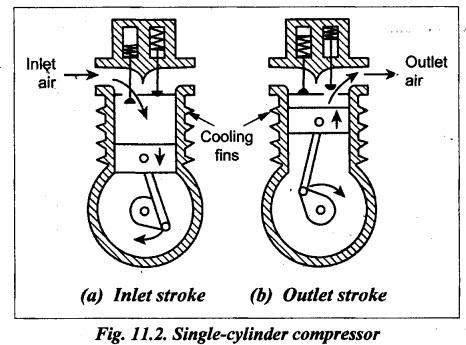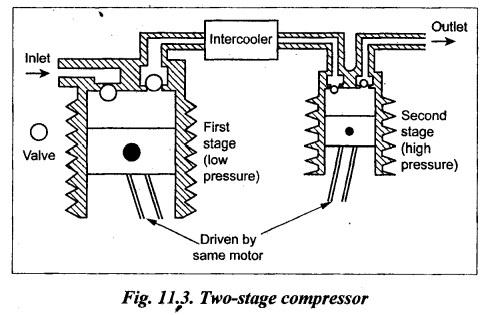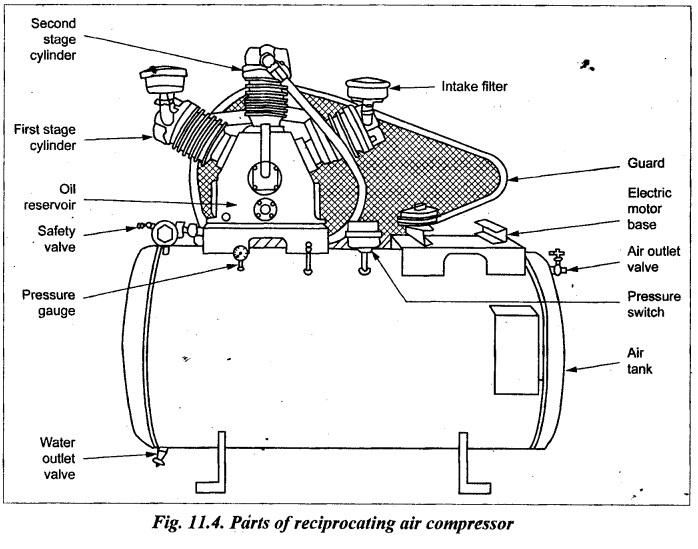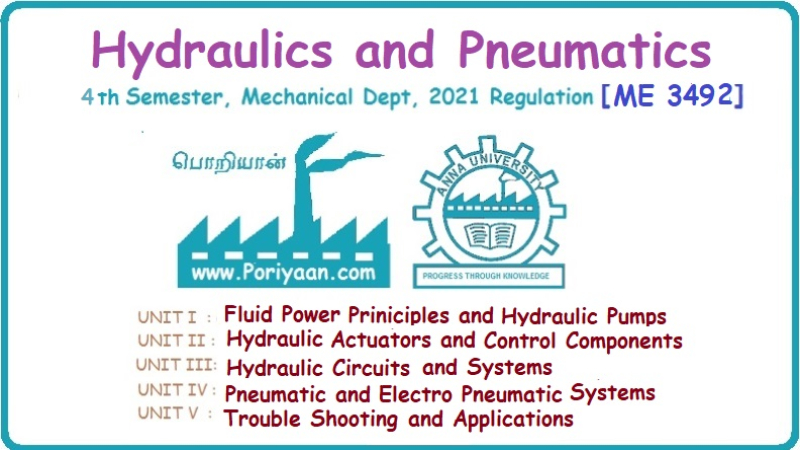Hydraulics and Pneumatics: Unit IV: Pneumatic and Electro Pneumatic Systems
piston-type reciprocating compressor
Construction, Operation, Advantages, Ranges
Piston compressors are the most commonly used compressors in the fluid power industry.
PISTON-TYPE RECIPROCATING COMPRESSOR • Piston compressors are the most commonly used compressors in the fluid power industry. • The construction and working of a piston-type reciprocating compressor is very much similar to that of an internal combustion (IC) engine. A typical piston-type reciprocating compressor consists of a cylinder, cylinder head, piston with piston rings, inlet and outlet valves, connecting rod, crank, crankshaft, bearings, etc. The arrangement of a basic single-cylinder compressor is illustrated in Fig.11.2. First a prime mover, mostly an electric motor, is used to drive the compressor unit. The electric motor supplies the rotary motion to the crank shaft, which in turn converted into reciprocating motion of piston through the crank and connecting rod arrangement. Inlet stroke: During the downward motion of the piston [Fig.11.2(a)], the pressure inside the cylinder falls below the atmospheric pressure and the inlet valve is opened due to the pressure difference. The air is drawn into the cylinder until the piston reaches the bottom of the stroke. Outlet stroke : As the piston starts moving upwards [Fig.11.2(b)], the inlet valve is closed and the pressure starts increasing continuously until the pressure inside the cylinder is above the pressure of the delivery side which is connected to the receiver. Then the outlet valve opens and air is delivered during the remaining upward motion of the piston to the receiver. Though a single-cylinder compressor can provide pressure upto about 10 bars, usually a multi-cylinder compressors (having 2 to 16 cylinders) are used for increasing compression capacity and also due to many practical reasons. • In single-stage compressor, the compression of the air from the initial pressure to the final pressure is carried out in one cylinder only. • When the compression of air from the initial pressure to the final pressure is carried out in more than one cylinder, then the compressor is known as multi-stage compressor. • Staging: Staging means dividing the total pressure among two or more cylinders by allowing the outlet from one cylinder into the inlet of the next cylinder and so on. • Why should we go for staging ? As we know, as per the general gas laws, the compression of air will result in significant increase in temperature. For instance, if a single-stage compressor gives the compressed air of about 5, bar, the compressed air temperature can rise to over 200°C. This in turn increase the motor power needed to drive the compressor. Thus the effective cooling of compressor is necessary. When the multistage compressors are used, the effective cooling can be implemented between stages. This effective cooling (i) reduces input power requirements, and (ii) increases the efficiency of the compressor. • A typical, self-explanatory, two-stage compressor arrangement is illustrated in Fig.11.3. • To get the practical feel of a compressor unit, the simple view of a reciprocating air- compressor unit showing various external parts is presented in Fig.11.4. 1. Piston type compressors are available in wide range of capacity and pressure. 2. The overall efficiency of piston compressors are high when compared to other compressors. 3. Very high air pressure and air volume flow rate can be obtained by using the multistage compressors. 4. Better mechanical balance can be achieved with multi-stage compressors. The single-stage piston compressors are available with capacities upto 1250 m3/hr and pressures of 10 bars. The multi-stage piston compressors are available with pressure upto about 350 bar. • Once a pressure has been developed in the compressed air piping, the established air pressure will push back against the compressor. This makes starting the compressor more difficult when required. So an arrangement called 'starting unloader control' is required to start the compressor whenever desired. This arrangement releases the pressure in the piping to the atmosphere and now the compressor is free to start whenever needed. • When the air compressor is started for the very first time, the starting unloader control is not required as there is no established pressure against which the compressor must start.1. Construction
2. Operation

3. Multi-cylinder Piston Compressors
4. Single-Stage and Multi-Stage Compressors


5. Advantages of Piston Type Compressors
6. Ranges
7. Need for Compressor Starting Unloader Control
Hydraulics and Pneumatics: Unit IV: Pneumatic and Electro Pneumatic Systems : Tag: : Construction, Operation, Advantages, Ranges - piston-type reciprocating compressor
Related Topics
Related Subjects
Hydraulics and Pneumatics
ME3492 4th semester Mechanical Dept | 2021 Regulation | 4th Semester Mechanical Dept 2021 Regulation
